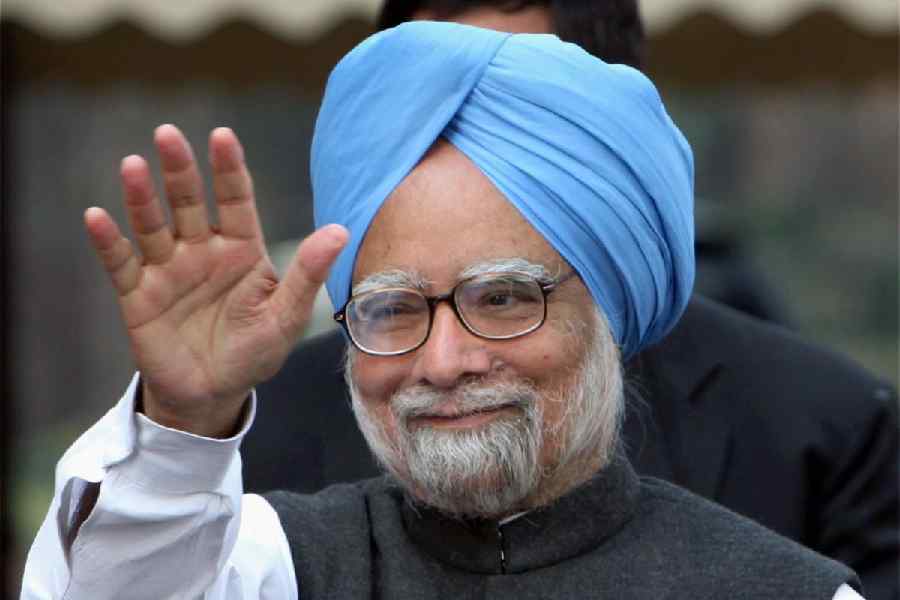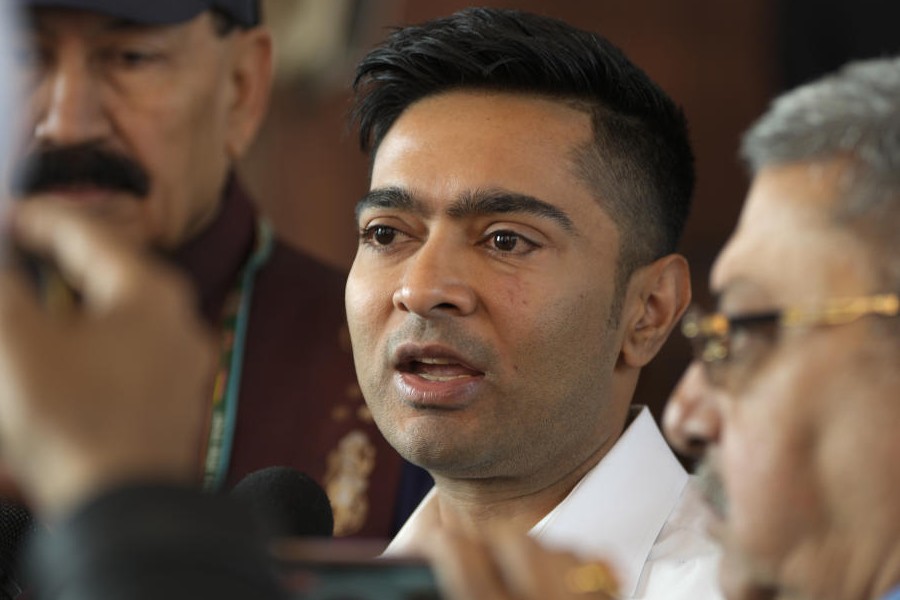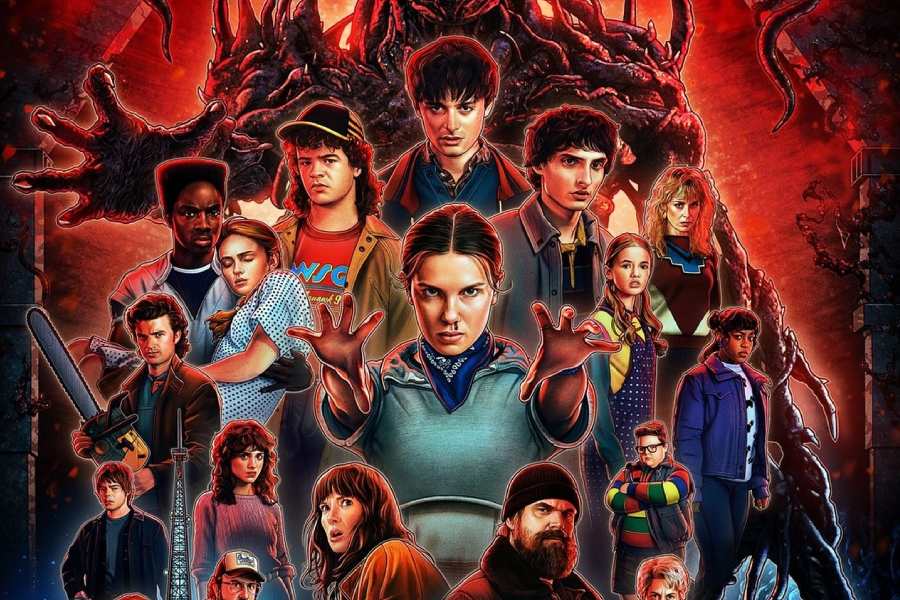 |
| Aparna and Kamaleswar discuss Meghe Dhaka Tara at the Shree Venkatesh Films office. Picture: Pabitra Das |
Ritwik to Satyajit to Rituparno — Aparna Sen and Kamaleswar Mukherjee explore their divergent worlds through Meghe Dhaka Tara
Aparna: So Kamal, you are a Ritwik fan, right?
Kamaleswar: Actually, the eye was trained by watching Satyajit Ray. I began to appreciate Ritwikbabu’s films much later.
A: Many people might think Meghe Dhaka Tara is a remake or a biopic. What is it?
K: It’s not a classical biopic. My film is about a fictitious character called Neelkantha Bagchi, influenced by an episode in Ritwik’s life, and we look at his past and future. He is not so acknowledged in life, like Ritwik Ghatak, so the similarity.
A: And so the name Meghe Dhaka Tara?
K: Yes, he got late acknowledgement in life, he’s like a meghe dhaka tara (cloud-capped star).
A: You think Ritwik didn’t get his due during his lifetime?
K: Yes, I don’t think so. He had eight releases, only one of them (Jukti Takko Aar Gappo) got a National Award, that too for storyline. In fact I wonder why Jukti Takko Aar Gappo was awarded best story since it’s one of his more difficult stories.
A: My most favourite Ritwik film is Ajantrik. It’s extraordinary. You know, now when I see Ritwik’s films, I feel that he might not have had the strength of construction of Satyajit Ray, but his visuals were so powerful! I didn’t realise this when I was younger.
K: Yes, I am influenced by his visuals. My personal Ritwik favourite is also Ajantrik.
A: But I didn’t realise that you were influenced by Ritwik when I saw your other film (Uro Chithi).
K: Yes, because there I had followed the classical storytelling style, mainly influenced by Satyajit Ray... we have rarely gone beyond Satyajit’s domain in our work...
A: By his domain you mean his narrative?
K: Yes, Ritwik’s narrative had elements of anarchy, incoherence, which also seemed very spontaneous. We haven’t worked much on those lines.
A: When he died… I remember he was very ill and admitted at PG hospital… some of us had gone to see him. Only a handful of people were there. And then he was taken to Technicians in a lorry… he went away in such an unloved way!
K: If we look at relationships, his ties with his family were not great, friends had drifted away... he was alienated from the political circle too.
A: But why would that have stopped people from acknowledging his talent?
K: I don’t think people understood his work enough at that time to give him his due.
A: But we have always thought of Ritwik as a huge talent. Ektu awgochhalo... but immensely talented. Even Manikkaka (Satyajit Ray) thought Ritwik was a huge talent.... So tell me, what prompted you to make a film on a chapter of Ritwik’s life?
K: I think Ritwik was a unique artiste, both in terms of form and content. Back then people didn’t accept his philosophy, nor did the power structure encourage it but he stuck to what he believed in. And maybe because emotions were so strong, he was a non-conformist. Another very interesting point is that despite being a Marxist in those days, Ritwik dealt with archetypes, the Jungian concept of collective unconscious... he tried to create an epic structure and he believed in the power of melodrama. He leant heavily on his indigenous roots. Our folk forms are melodramatic and probably to connect with people, he used it extensively. Like in Komal Gandhar and Subarnarekha.
 |
| A moment from Meghe Dhaka Tara, which releases this Friday |
A: Yes, Subarnarekha is too melodramatic in parts, but what fantastic visuals!
K: I feel the use of excessive melodrama was deliberate. And while we always try to come out of archetypes to break cliches, Ritwik used archetypes because he felt people would relate better as these are a part of our collective unconscious. He always said that he wanted to be a people’s artiste.
A: But was he truly a people’s artiste?
K: No. He always wanted to but he couldn’t be.
A: Kamal, you are influenced by both Satyajit and Ritwik. What do you think is the intrinsic difference between the two?
K: Satyajit had extraordinary storytelling powers, his writing prowess was unmatched… we have literally mugged up his dialogues… his films were marked by strong performances and his detailing was impeccable. Also, his choice of stories was remarkable...
A: Well, Satyajit too made a rural film like Pather Panchali, but the urban sensibility accepted him more than Ritwik. Why do you think so?
K: I feel it’s primarily because of Satyajit’s storytelling skills. Ritwik wanted to catch the rural, subaltern section.
A: I feel both their standpoints are extremely valid. We look at the rural through our educated urban sensibility and that’s why Satyajit was more acceptable. In Ritwik, the bizarre element was very strong, which I think many couldn’t take.
K: Yes, that’s true.
A: There’s a constant reference to Partition in Ritwik’s films...
K: Yes. Though he was not a refugee himself, he had seen the influx of refugees a lot. He always felt very strongly for Opaar Bangla and at some point that might have been traumatic for him. It became a pivotal point in his films.
A: Both Satyajit and Ritwik delved deep into their roots and yet, Satyajit seems more international, isn’t it?
K: Yes certainly so, because Satyajit’s subjects have an ‘international’ quality about them. For instance, the essential emotions of Nayak are universal and they would be as relatable in France.
A: So you feel Ritwik’s films are very ethno-specific?
K: Yes, and I think it brings in a lot of variety.
A: But it has to be within the ambit of one’s understanding, otherwise the nuances may be lost on the viewer.
K: That’s true. When watching Bergman, for instance, I often can’t relate to the heavy Christian symbolism and I tend to lean towards the visuals.
A: In both Satyajit and Ritwik’s films, there are moments of transcendence. How would you differentiate their devices of achieving that?
K: I feel Satyajit’s preparatory phase is long and gradual. In Ritwik, when that moment of transcendence comes, there’s theatricality. It’s sudden, it’s dramatic. Both have very different kinds of impact. In Ritwik, it feels jerky at times but the impact is overwhelming nonetheless.
A: Well, I have a take on this (smiles)… If we think of that scene in Titash Ekti Nadir Naam where the girl dies and her face looks like Durga being immersed, now that’s rooted in a specific culture. It’s a reminder for us, but not for the rest of the world. That is one kind of transcendence.... In Satyajit, I feel the transcendence is more Rabindrik, it’s like Upanishad. It goes to a mystical level. I feel the essential difference is that one is very folk, the other is very Upanishad-like.
K: That’s a beautiful analogy.
A: You are right too. One is of acceptance, the other is like a jolt!... Well, Kamal, Ritwik is a non-conformist, while Satyajit conformed — to the classical, not to the populist. Now Rituparno (Ghosh) definitely was non-conformist in his later films and still he was hugely accepted. Why do you think that happened?
K: I feel Rituda’s films also had a Rabindrik classicism. There’s a very soothing, pleasant quality.
A: In a way that engages the urban sensibility, yes…. But the way Ritu created rupantarkami manush or human being beyond gender, you say there was a beauty in that too which appealed to us?
K: After watching Chitrangada, I felt that leaving the homosexuality aspect aside, it was a story of an individual wanting to become a better person. And the way it was shown, there was nothing jarring. It’s very gentle. Ritwik, I feel, is too gritty for just about anyone to see and like. If you’ve got the eye for his films, then you would look at it differently.
A: So what’s the timeline of your Meghe Dhaka Tara?
K: The period is 1969, when Ritwik was admitted in a mental asylum for shock therapy. It’s banned in India now but back then he would be given shocks of 150 volt at a time, which could be lethal. The reason was that he would smuggle in liquor even at the asylum. And he was in a bizarre frame of mind. There he wrote a play which he also staged with the other inmates. So in the film, we create a thought space where he roams about. And here all kinds of issues are coming to him at random...
A: Like stream of consciousness?
K: Yes, and there’s a doctor (played by Abir Chatterjee) who’s counselling him on the addiction and we are going back and forth to get information on his life. It’s a very non-linear structure.
A: And how do you think this non-linear approach will go down with the audience?
K: (Smiles) I can only hope they like it.
A: You know, it’s sad that a filmmaker works so hard, does so much research to make a film, and then the audiences sometimes just don’t bother. People want an easy way out. But they also have the responsibility to try and understand a film. Or else how will good films be made? The audiences also have to work a little.... But I really liked the fact that people saw Shabdo....
K: Well, Rinadi, I saw Yugant four times at the theatre. It was not an easy film to understand but there was an acceptance for it. People understand a film at different levels.
A: Do you think Ritwik is still relevant?
K: Definitely. Border crisis is a major issue in international films. And personally, I feel strongly about the two separated Banglas. I feel it’s a pretentious border.
A: (Smiles) Shadow lines… I feel this is true for all borders around the world.











